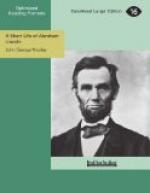While these events were taking place to the north, equally threatening incidents were occurring to the south of Washington. The State of Virginia had been for many weeks balancing uneasily between loyalty and secession. In the new revolutionary stress her weak remnant of conditional Unionism gave way; and on April 17, two days after the President’s call, her State convention secretly passed a secession ordinance, while Governor Letcher ordered a military seizure of the United States navy-yard at Norfolk and the United States armory at Harper’s Ferry. Under orders from Washington, both establishments were burned to prevent their falling into insurrectionary hands; but the destruction in each case was only partial, and much valuable war material thus passed to rebel uses.
All these hostile occurrences put the national capital in the greatest danger. For three days it was entirely cut off from communication with the North by either telegraph or mail. Under the orders of General Scott, the city was hastily prepared for a possible siege. The flour at the mills, and other stores of provisions were taken possession of. The Capitol and other public buildings were barricaded, and detachments of troops stationed in them. Business was suspended by a common impulse; streets were almost deserted except by squads of military patrol; shutters of stores, and even many residences, remained unopened throughout the day. The signs were none too reassuring. In addition to the public rumors whispered about by serious faces on the streets, General Scott reported in writing to President Lincoln on the evening of April 22:
“Of rumors, the following are probable, viz.: First, that from fifteen hundred to two thousand troops are at the White House (four miles below Mount Vernon, a narrow point in the Potomac), engaged in erecting a battery; Second, that an equal force is collected or in progress of assemblage on the two sides of the river to attack Fort Washington; and Third, that extra cars went up yesterday to bring down from Harper’s Ferry about two thousand other troops to join in a general attack on this capital—that is, on many of its fronts at once. I feel confident that with our present forces we can defend the Capitol, the Arsenal, and all the executive buildings (seven) against ten thousand troops not better than our District volunteers.”




